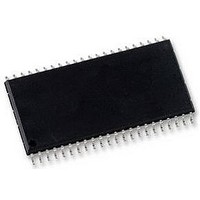AM29F016D-90SF Spansion Inc., AM29F016D-90SF Datasheet - Page 23

AM29F016D-90SF
Manufacturer Part Number
AM29F016D-90SF
Description
IC, FLASH, 16MBIT, 90NS, SOIC-44
Manufacturer
Spansion Inc.
Datasheet
1.AM29F016D-120ED.pdf
(44 pages)
Specifications of AM29F016D-90SF
Memory Type
Flash
Memory Size
16Mbit
Memory Configuration
2M X 8
Ic Interface Type
Parallel
Access Time
90ns
Supply Voltage Range
4.5V To 5.5V
Memory Case Style
SOIC
No. Of Pins
44
Lead Free Status / RoHS Status
Lead free / RoHS Compliant
RY/BY#: Ready/Busy#
The RY/BY# is a dedicated, open-drain output pin that
indicates whether an Embedded Algorithm is in
progress or complete. The RY/BY# status is valid after
the rising edge of the final WE# pulse in the command
sequence. Since RY/BY# is an open-drain output, sev-
eral RY/BY# pins can be tied together in parallel with a
pull-up resistor to V
If the output is low (Busy), the device is actively erasing
or programming. (This includes programming in the
Erase Suspend mode.) If the output is high (Ready),
the device is ready to read array data (including during
the Erase Suspend mode), or is in the standby mode.
Table
agrams for read, reset, program, and erase shows the
relationship of RY/BY# to other signals.
DQ6: Toggle Bit I
Toggle Bit I on DQ6 indicates whether an Embedded
Program or Erase algorithm is in progress or complete,
or whether the device has entered the Erase Suspend
mode. Toggle Bit I may be read at any address, and is
valid after the rising edge of the final WE# pulse in the
command sequence (prior to the program or erase op-
eration), and during the sector erase time-out.
During an Embedded Program or Erase algorithm op-
eration, successive read cycles to any address cause
DQ6 to toggle. (The system may use either OE# or
CE# to control the read cycles.) When the operation is
complete, DQ6 stops toggling.
After an erase command sequence is written, if all
sectors selected for erasing are protected, DQ6 tog-
gles for approximately 100 µs, then returns to reading
array data. If not all selected sectors are protected,
the Embedded Erase algorithm erases the unpro-
tected sectors, and ignores the selected sectors that
are protected.
The system can use DQ6 and DQ2 together to deter-
mine whether a sector is actively erasing or is erase-
suspended. When the device is actively erasing (that is,
the Embedded Erase algorithm is in progress), DQ6
toggles. When the device enters the Erase Suspend
mode, DQ6 stops toggling. However, the system must
also use DQ2 to determine which sectors are erasing
or erase-suspended. Alternatively, the system can use
DQ7 (see the subsection on
If a program address falls within a protected sector,
DQ6 toggles for approximately 2 µs after the program
command sequence is written, then returns to reading
array data.
DQ6 also toggles during the erase-suspend-program
mode, and stops toggling once the Embedded Pro-
gram algorithm is complete.
November 16, 2009 21444E9
10
shows the outputs for RY/BY#. The timing di-
CC
.
“DQ7: Data#
Polling”).
D A T A
Am29F016D
S H E E T
The Write Operation Status table shows the outputs for
Toggle Bit I on DQ6. Refer to Figure
algorithm, and to the Toggle Bit Timings figure in the
“AC Characteristics” section for the timing diagram.
The DQ2 vs. DQ6 figure shows the differences be-
tween DQ2 and DQ6 in graphical form. See also the
subsection on
DQ2: Toggle Bit II
The “Toggle Bit II” on DQ2, when used with DQ6, indi-
cates whether a particular sector is actively erasing
(that is, the Embedded Erase algorithm is in progress),
or whether that sector is erase-suspended. Toggle Bit
II is valid after the rising edge of the final WE# pulse in
the command sequence.
DQ2 toggles when the system reads at addresses
within those sectors that have been selected for era-
sure. (The system may use either OE# or CE# to
control the read cycles.) But DQ2 cannot distinguish
whether the sector is actively erasing or is erase-sus-
pended. DQ6, by comparison, indicates whether the
device is actively erasing, or is in Erase Suspend, but
cannot distinguish which sectors are selected for era-
sure. Thus, both status bits are required for sector and
mode information. Refer to Table
puts for DQ2 and DQ6.
Figure
form, and the section
algorithm. See also the
Refer to the Toggle Bit Timings figure for the toggle bit
timing diagram. The DQ2 vs. DQ6 figure shows the dif-
ferences between DQ2 and DQ6 in graphical form.
Reading Toggle Bits DQ6/DQ2
Refer to Figure
ever the system initially begins reading toggle bit
status, it must read DQ7–DQ0 at least twice in a row
to determine whether a toggle bit is toggling. Typically,
a system would note and store the value of the toggle
bit after the first read. After the second read, the sys-
tem would compare the new value of the toggle bit
with the first. If the toggle bit is not toggling, the device
has completed the program or erase operation. The
system can read array data on DQ7–DQ0 on the fol-
lowing read cycle.
However, if after the initial two read cycles, the system
determines that the toggle bit is still toggling, the
system also should note whether the value of DQ5 is
high (see the section on DQ5). If it is, the system
should then determine again whether the toggle bit is
toggling, since the toggle bit may have stopped tog-
gling just as DQ5 went high. If the toggle bit is no longer
toggling, the device has successfully completed the
program or erase operation. If it is still toggling, the
device did not complete the operation successfully, and
5
shows the toggle bit algorithm in flowchart
“DQ2: Toggle Bit
5
for the following discussion. When-
“DQ2: Toggle Bit II”
“DQ6: Toggle Bit I”
II”.
10
5
to compare out-
for the toggle bit
explains the
subsection.
21















